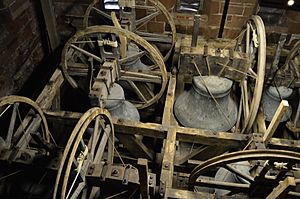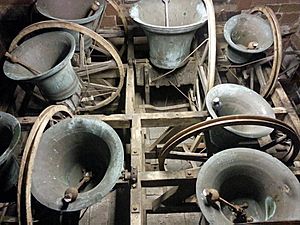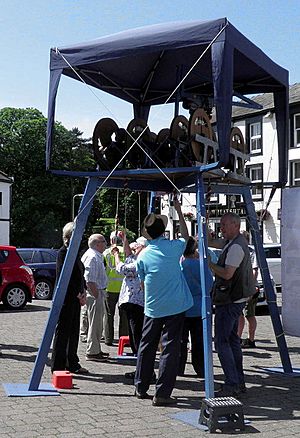Ring of bells facts for kids
A ring of bells is a group of bells that are set up for a special way of ringing called full circle ringing. Bell ringers use this term. Sometimes, people also say peal of bells. However, a "peal" can also mean a very long ringing performance with more than 5,000 changes in the bell patterns.
In the early 1600s, people learned that by swinging a bell in a full circle, they could easily change how fast it rang. This meant they could control the timing between each bell's sound very precisely. This ability led to the development of change ringing. In change ringing, the order in which the bells strike is changed to create different and musical sounds.
Most rings of bells are found in church towers, especially in England. These towers can have anywhere from three to sixteen bells. Towers with six or eight bells are the most common. The bells are tuned to the notes of a diatonic scale, like the notes on a piano. They can weigh from about 100 kilograms (a few hundred pounds) up to 4,000 kilograms (a few tons). Churches often use them to call people to worship. There are also smaller rings of bells, called "mini-rings." These are used for training, showing how bells work, or just for fun. Their bells weigh only a few kilograms.
Contents
How Bells Work: The Mechanism

A full-circle bell hangs from a headstock with special bearings. It can swing in an arc of more than 360 degrees. A rope wraps around a large circular bell wheel to make the bell swing back and forth. Ringers control the bell's speed by changing how wide the arc of its swing is. A wider swing means the bell strikes slower.
The bells are held in a strong bellframe, which can be made of steel or wood. Each bell hangs from a headstock that has trunnions (bearings). These bearings let the bell assembly spin. When the bell is still, in the "down" position, its weight (and the clapper's weight) is below the center of the supports. This makes the bell act like a pendulum. The ringer's rope helps control this movement.
The headstock has a wooden stay. This stay works with a slider to stop the bell from spinning too far, usually just under 370 degrees. A large wooden wheel is attached to the headstock, and the rope is tied to it. The rope winds and unwinds as the bell swings. This is what makes full circle ringing different from bells that just chime (which means they swing only a little).
Inside the bell, the clapper is a metal bar with a heavy ball. It swings in the same direction as the bell. The clapper hits the soundbow, which is the thickest part of the bell's mouth, to make the sound. A part called the flight helps control the clapper's speed.
How to Ring a Bell
The rope is attached to one side of the bell wheel. This means different amounts of rope wind on and off as the bell swings. The first pull is called the handstroke. Only a small amount of rope is on the wheel. The ringer pulls on the sally (a soft, woolly part of the rope). As the bell swings up, it pulls more rope onto the wheel, and the sally rises high, sometimes even to the ceiling. The ringer holds onto the tail-end of the rope to control the bell.
After a short, controlled pause with the bell balanced almost upside down, the ringer pulls the backstroke. They pull the tail-end, which makes the bell swing back towards its starting position. As the sally rises again, the ringer catches it to pause the bell at its balance point.
Each time a bell is pulled, it starts from a mouth-upwards position. As the ringer pulls the rope, the bell swings down and then back up on the other side. During this swing, the clapper inside hits the soundbow, making the bell ring. Each pull reverses the bell's direction. The swings are called "handstroke" and "backstroke" in turn. After the handstroke, most of the rope is wrapped around the wheel, and the ringer's arms are above their head, holding the rope's tail end. After the backstroke, most of the rope is free, and the ringer holds the rope comfortably, usually by the sally.
Normally, one ringer is needed for each bell. This is because the bells are heavy, and controlling the rope takes skill.
Where Bells Are in the Tower
The bells are usually placed in an upper room of the tower called a belfry. Their ropes hang down into the room below, called the ringing chamber, forming a circle. Most often, the ropes form a clockwise circle, but some are anticlockwise.
Unlike most musicians who count up, bell ringers number their bells downwards. The lightest and highest-sounding bell is called the treble. Then comes the "2", the "3", and so on, down to the heaviest and deepest-sounding bell, which is called the tenor. In some towers, a bell even larger than the tenor might be called a bourdon.
About 1.5 meters (5 feet) from the floor, the rope has a soft, woolly grip called the sally (usually about 1.2 meters or 4 feet long). The very end of the rope is folded over to make an easy-to-hold tail-end.
How the Clapper Strikes
In English-style ringing, the bell is swung up so that the clapper rests on the lower edge of the bell when the bell is balanced on its stay.
During each swing, the clapper moves faster than the bell. It eventually hits the soundbow, making the bell ring. The bell makes its sound roughly when it is horizontal as it rises. This helps the sound travel outwards. The clapper then bounces back slightly, allowing the bell to continue ringing. When the bell reaches its balance point, the clapper passes over the top and rests against the soundbow.
The Special Sound of Full-Circle Bells
The sound made by a bell rung full-circle has two unique features.
First, because the clapper rests against the bell right after hitting it, the sound quickly fades away. This allows many bells to strike one after another, like in change ringing, without their sounds overlapping too much and becoming blurry.
Second, the movement of the bell adds a doppler effect to the sound. This happens because the bell is still moving when the clapper strikes, just as it reaches its highest point.
Both these effects give full-circle ringing a special sound. This sound cannot be copied by bells that are stationary and just chimed, as those sounds take longer to fade.
Bell Decorations
Tower bells often have words or pictures cast onto their sides. These might simply be the name of the company that made the bell or the person who donated it. Sometimes, bells are given names or have short sayings. For example, at Amersham in Buckinghamshire, the tenor bell says: "Unto the Church, I do You call, Death to the grave will summon all." Because tenor bells are often rung at funerals, they sometimes have serious sayings like this. The sayings on treble bells are often more cheerful. The treble bell at Penn, Buckinghamshire, for example, reads "I as trebell doe begin."
Dove's Guide for Bell Ringers
A very important book for bell ringers is Dove's Guide for Church Bell Ringers. This guide lists all the towers around the world that have bells set up for full-circle ringing. As of 2021, the guide listed 5,756 rings of bells in England, 182 in Wales, 37 in Ireland, 22 in Scotland, 10 in the Channel Islands, and 2 in the Isle of Man. There are also 142 other towers worldwide with full-circle bells. Australia has 64 rings of bells. Other countries with these bells include Italy, the USA, Canada, France, Netherlands, Belgium, New Zealand, South Africa, Kenya, Zimbabwe, and Pakistan.
Bell ringing has been very popular in England for hundreds of years. Because of this, many pubs (public houses or bars) across the country are named "The Ring of Bells."
Bell Ropes
Bell ropes are specially made for ringing. They have the sally, a woollen grip, woven right into the rope strands. Ringers prefer ropes made from natural fibers, like flax (which replaced Indian hemp). These are softer on the ringers' hands. However, the part of the rope between the sally and the bell can be made of a strong synthetic rope that doesn't stretch much. This helps reduce bounce.
Rope splicing is very important in English-style ringing. Carefully joining ropes can make them last longer. This is because ropes tend to wear out in specific spots, like where they pass through a hole or over a pulley, rather than the whole rope wearing out evenly.
Important Bell Ringing Words
- Backstroke - The part of a bell's swing that starts when the ringer pulls the tail end of the rope.
- Band - A group of people who ring a set of bells.
- Clapper - The metal hammer inside the bell that hits the soundbow to make the bell sound.
- Handstroke - The part of the bell's swing when the ringer grips the sally.
- Sally - The soft, woolly bulge woven into the bell rope. It helps the ringer grip the rope and shows them where to hold it.
- Slider - A device that lets the bell swing slightly past its balance point at each end of its swing, but stops it from spinning too far.
- Stay - A wooden piece attached to the headstock that works with the slider to control the bell's movement.
- Tenor - The heaviest bell in a ring, which makes the lowest sound.
- Treble - The lightest bell in a ring, which makes the highest sound.




